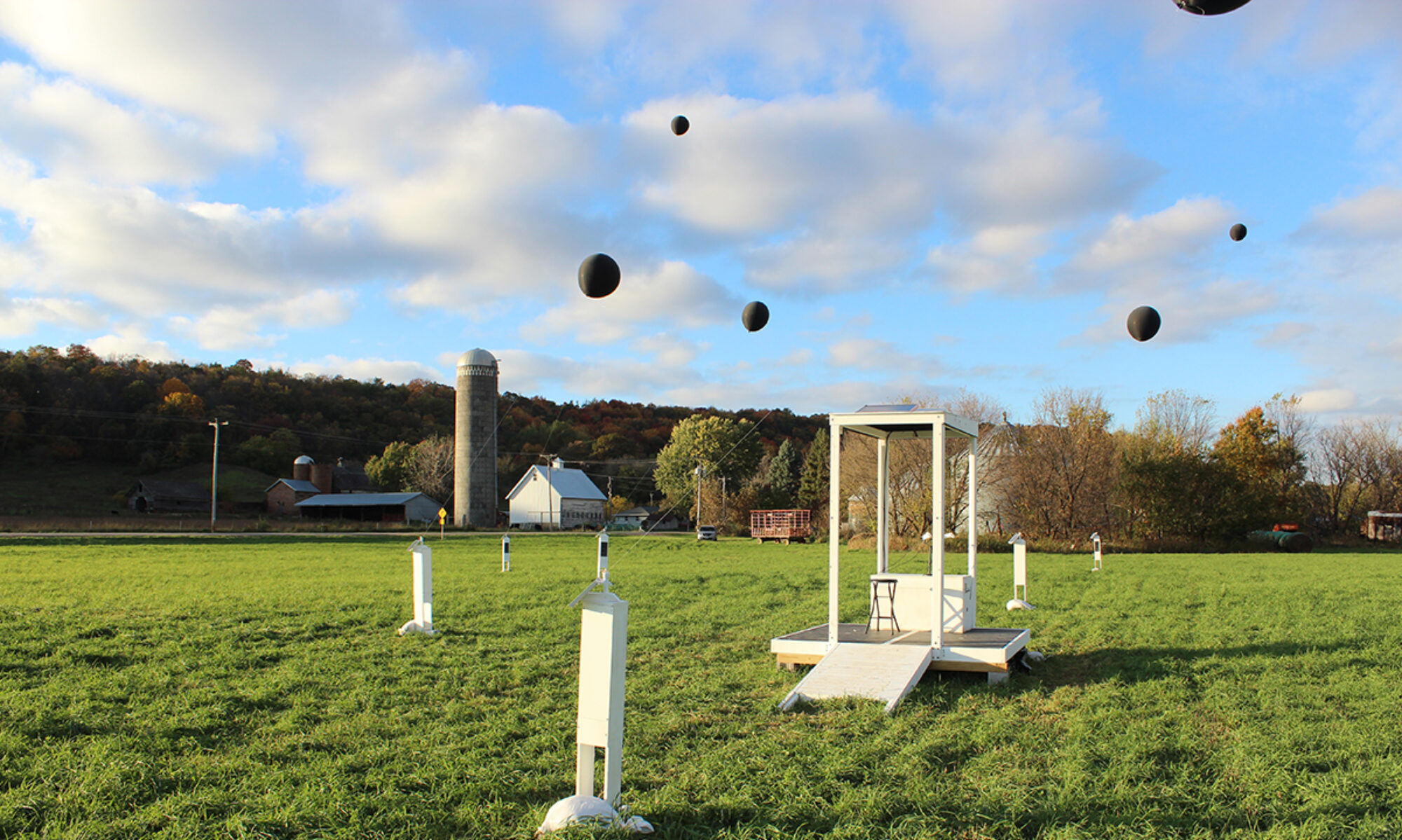This section contains a summary of projects and exhibitions that show the quality and calibre of my exhibition record, research, and trajectory in the field of contemporary art.
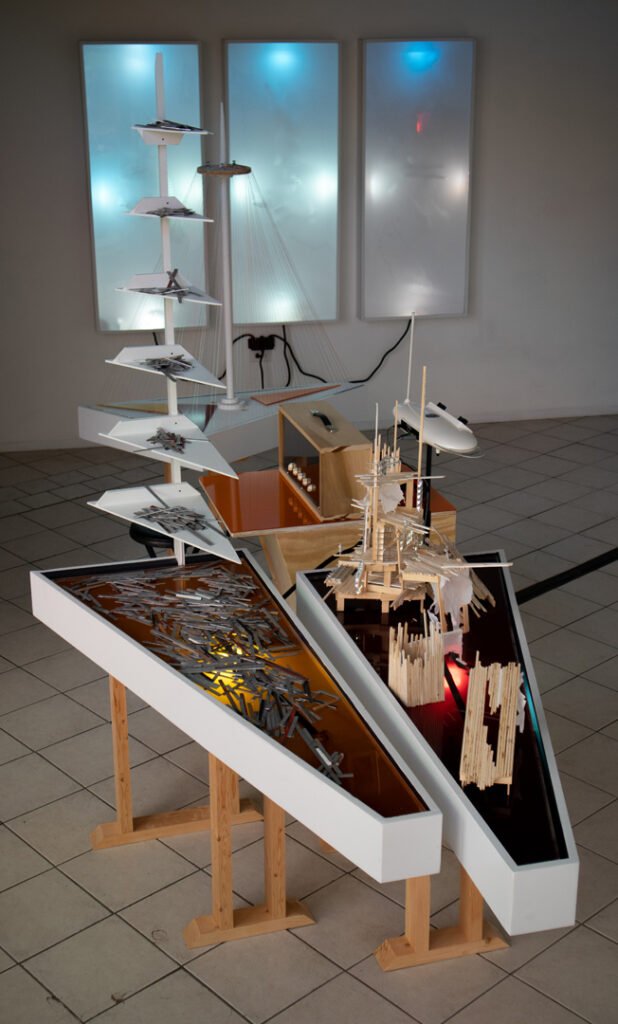
a. Big Bad Anthropocene Machine
Big Bad Anthropocene Machine is a series of installations that fold in performance, Big Bad Anthropocene Machine is a series of installations that enfold performance, interactive kinetic sculpture, electronics, sound and video work. This work is an exploration of current social, political and economic conditions. The indeterminate outcomes of systems we maintain form a perpetual state of change. This is the active force from which the work is inspired. The unfolding of perpetual change throughout an exhibition or performance along with the stasis of non-participation. Started in 2018 the project encompasses video, interactive kinetic sculpture and sound, as well as electronics based interaction where the viewer can modify the outcome of the work. The emphasis of the work is to relay strategies from which to contemplate systems and the underlying structures of contemporary life. The fulcrum of the work is a balance between entropy and participation. It is performed through electronic and computerized control while simultaneously modified by the audience.
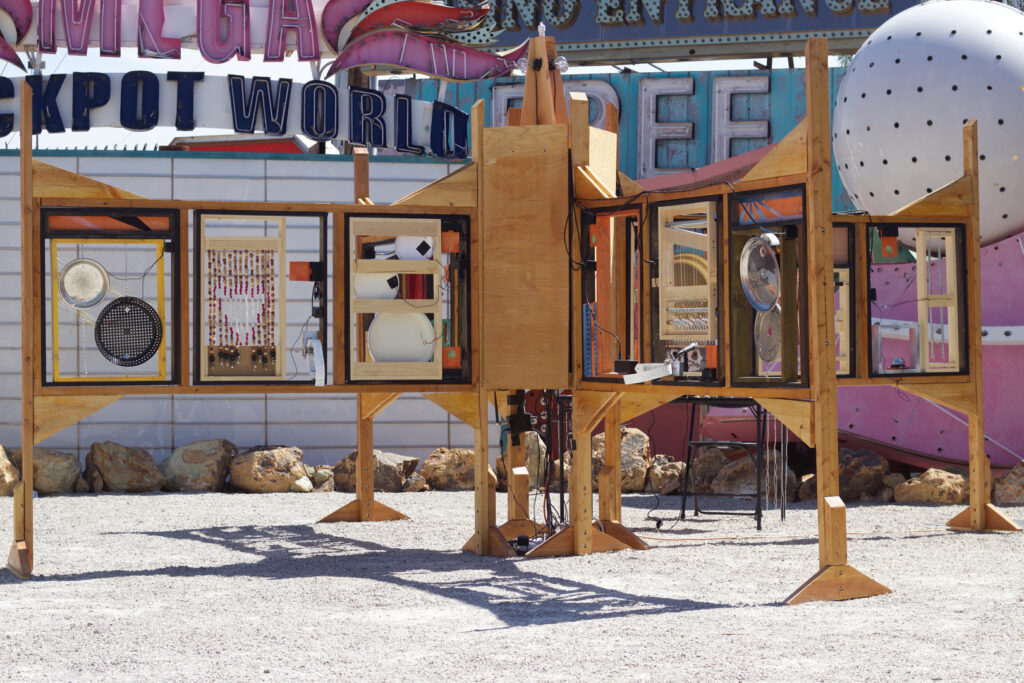
n o w h e r e r a d i o 2015 Neon Museum Artist Residency Installation Documentation
b. n o w h e r e r a d i o
n o w h e r e r a d i o was first executed in a town called Badger in 2010 at the foothills of the Sequoia National Park. The exhibition was curated by New York Artists Tom McGlynn and Bill Doherty, and California artists Bachrun LoMele and Anné Klint. The exhibition was completed in a large industrial building on an airfield in a very remote region that allowed ample space to accelerate experimentation and create unique works of art.
n o w h e r e r a d i o, has evolved to broadcast the collaborative efforts of multiple itinerant audiences. The evolution of the work has become more site specific and in certain cases based on issues and ideas prevalent in the region that it is installed. n o w h e r e r a d i o is composed of experimental sound devices and instruments, microphones, armatures, a mixer, digital processors, an array of radio receivers ranged in open spaces to form a sounds scape and a low powered FM transmitter, it is designed to be highly transportable and can run on the battery of a standard car. Participants are encouraged to create their own sounds and generate their own projected and broadcasted thoughts and ideas
Here is a list of exhibits of n o w h e r a d i o:
2018 Fermentation Fest Farm/Art Dtour Sauk County, Wisconsin (large scale outdoor installation)
2015 (re)Happening Black Mountain College, Black Mountain, North Carolina (interactive installation)
2015 citizen speak The Neon Museum, Las Vegas Nevada (interactive installation) (solo)
2015 citizen speak The Barrick Museum, University of Las Vegas, Nevada (interactive installation)(solo)
2013 Beautiful Fields: Memphis Social, an Apex Art Franchise Exhibition Memphis Tennessee Curated by Tom McGlynn(Installation)
2012 Art Murmur, Oakland California (mixed media electronic installation)
2012 Somebody Kill The Radio, Kleven Contemporary, Las Vegas Nevada (mixed media electronic installation)(solo)
The intent of this first iteration of n o w h e r e r a d i o was to give people the opportunity to adjust the outcome of an art exhibit through participation. The function of interactivity can create a relationship between the participant and the broadcast. The relationship becomes intriguing when the audience becomes a momentary community and a set of exchanges of ideas are expressed through the broadcasted range.
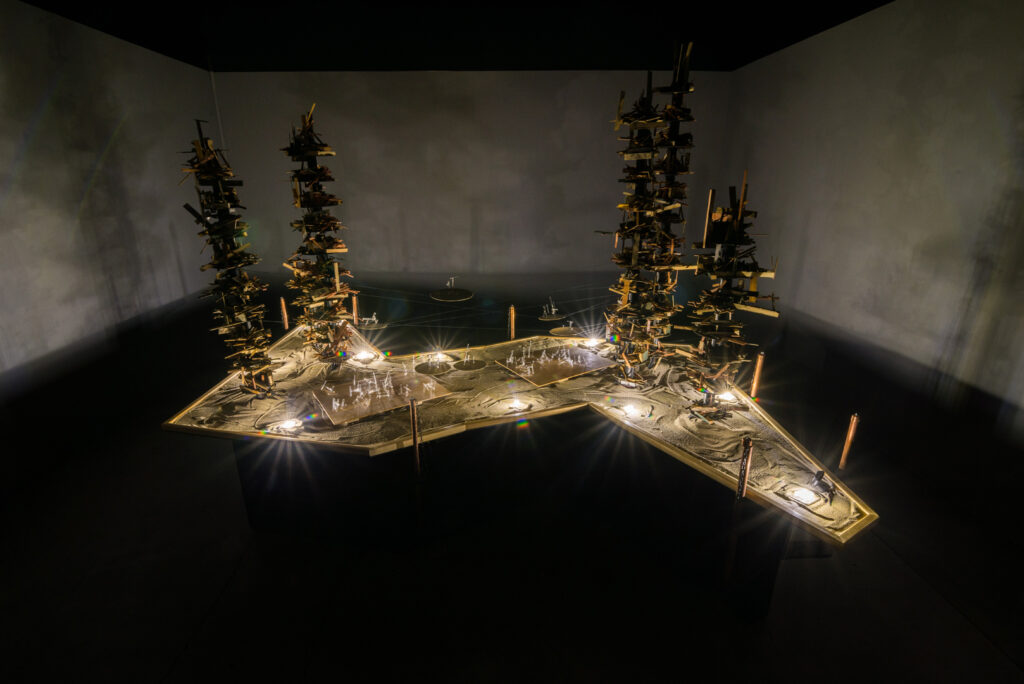
c. New Citadel
Participation
New Citadel is designed as a project that enables viewers to take part in the cacophonous movements of urbanism and to embrace individuality within the multitudinous effort. The installation permits visitors to build a model city inclusive of the audience’s own ideas of future growth and development. Architectural model making materials are provided and instructions are given on basic architectural design. The citadel starts to populate itself with the creations of its visitors, each one adding a new element to the project. Each construction is a manifestation of the individual working in a larger group, while discussions on urbanism and democratic process are encouraged. Participants are asked, “How effective is their participation and what benefits could there be to a more open process of determining the change around us?”.
This project is an extension of past efforts to convey ideas of generation and decay of the complex systems and structures that surround us. Like Gustave Metzger’s work, it is dependent on the idea that creation and destruction are a unified action. Human and natural intervention upon our landscapes are often at odds with the social, architectural, biological and economical systems that exist or are created to support us. While natural systems are based on patterns, global warming studies suggests that we can expect that uncertainty will be a prevalent factor in forecasts and climactic conditions. Human systems are often adapted to comply to global economic values. These values imply that secondary or tertiary needs are not important in a financial sense therefore unimportant in a general sense. This project emulates the constant reconstuctivism induced by perpetual states of maintenance and decay, the perpetual confrontation of the demands of human and natural systems in relation to their purpose, usefulness and expiration. The solution suggested in the work to the rapidly declining resources, and in many ways to the problems arising from the lack of equitable distribution of these resources, is the embracing and the advancement of an infinitely more modern democratic approach to changing the landscape.
Cacophony
Through devices and control panels made available to visitors, change and reorganizing is produced in the city through sound. This component of the participatory and interactive experience is accomplished through kinetic forces brought about by the power of sonic frequencies. The result of the sonic intervention is a constantly changing city that is perpetually being re-evaluated and rebuilt by its participants, placing the process of system creation and regeneration in the hands of anyone willing to affect change rather, than anyone with influence. The project in its final stage addresses retirement, archiving and documentation of the changing platforms, interventions and history of New Citadel. This stage of the process as it is for any organized effort is one of reflexion and evaluation of the project itself. Often the documentation stands alone as the aesthetic remnant of what was accomplished in the collaboration.
Documents and Recordings
While Citadel is being built by visitors, the project is also documented exhaustively through audio, video and photography. These documents and recordings chronicle the visual and audible experiences within new citadel and are used as standalone works of visual art to be exhibited elsewhere.
d. Beyond Sunrise Mountain
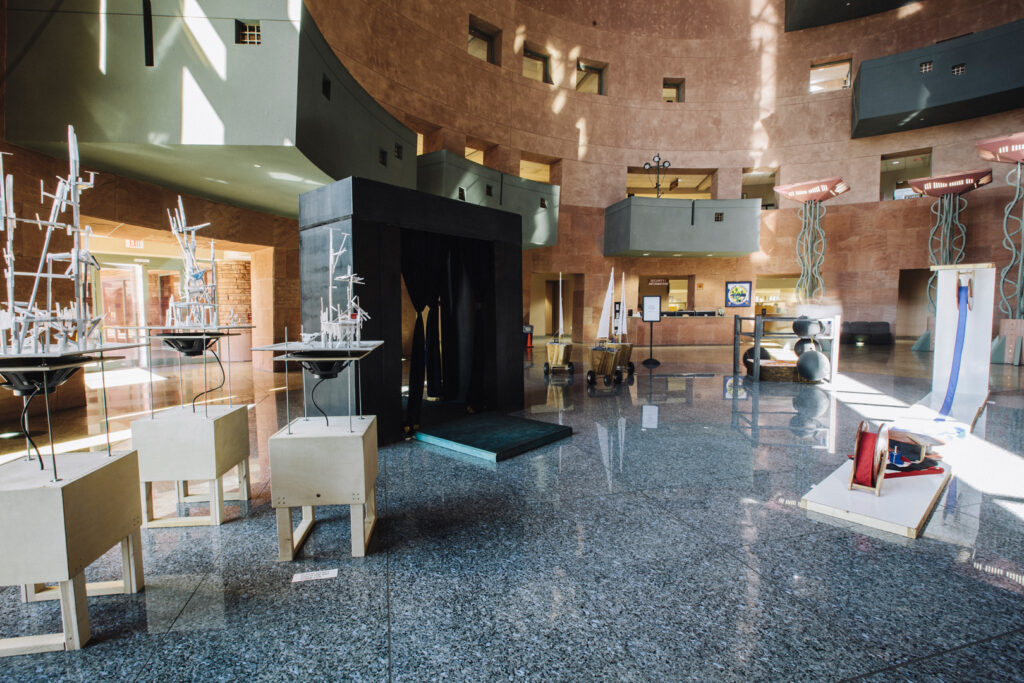
Beyond Sunrise Mountain is a project started in 2008 and culminated in an exhibition at the Clark County Government Center, in Las Vegas, Nevada. Rather than looking at the Mojave Desert as a vast range of homogenous land, I decided to pick a small portion of the desert in a location near the city of Las Vegas. I embarked on frequent visits to this site chronicling the area with photography and video as well as creating temporary installations and interventions on the landscape. The study of Sunrise Mountain had several goals that included: the human alteration of landscape, geological processes, the historical, social and political narrative in the south western region of the United States. The majority of the research and projects were completed in areas around the Sunrise Mountain east of Las Vegas, Nevada.
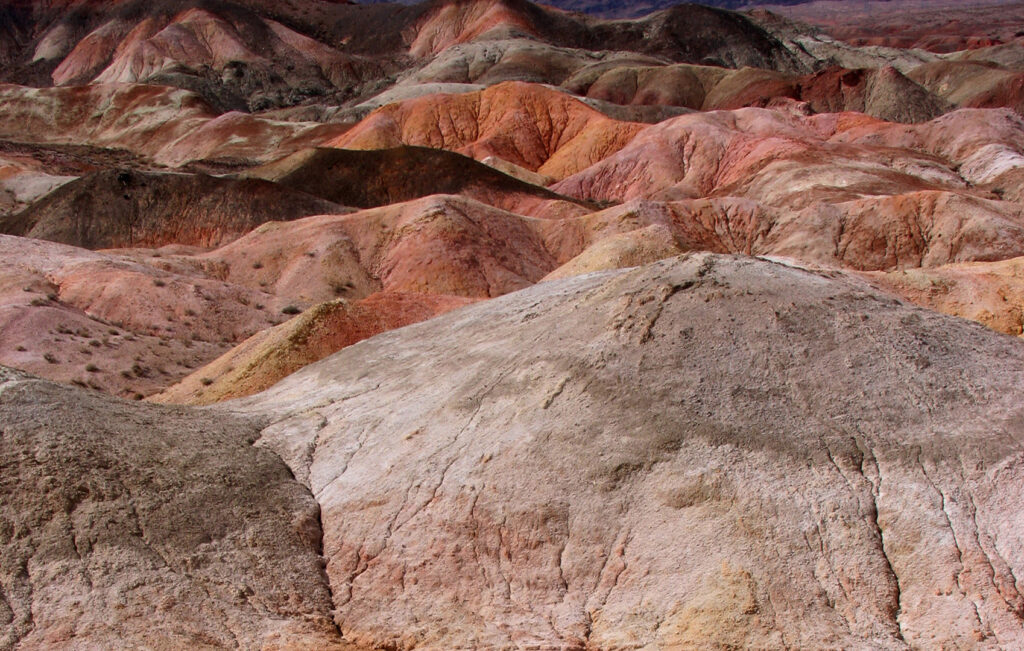
An Industrial Rainbow
The Sunrise Mountain Area is composed of a very deep and large gypsum sedimentary deposit, pyroclastic rock sandstone clays, sulfides and other mineral deposits. The area is also known to be called “Rainbow Gardens”. Pabco a gypsum board factory sits to the north. Nellis Air Force Base Area 2, a storage area for munitions that allegedly include nuclear weaponry, is north-east, Lake Mead is south. It is an area crossed north to south by high tension wires owned by Los Angeles Department of Water and Power, connecting a Utah power plant to the Southern California power grid. It is an area that is frequented by accidental death on the roadway. The often stereotyped image of southwestern abandonment is complete with mountains of broken glass, boats on the side of the road, metal burn offs, (stolen copper wire melted down into ingots), bullet casings and other refuse. The meteorological conditions eat away at these remnants with grinding efficiency on a timeframe that humans rarely have patience for. The corroding leaflet advertising massage services that drifted for miles along the desert reminds one of the proximity to Las Vegas and our incursion on the land.
Frontierism
The frontier of the 19th century existed somewhere beyond the western horizon where riches and fortunes were to be discovered by mainly European immigrants. Through centuries of destructive and genocidal western expansion of The United States, the brutal exploitation of natural resources and American landscape are the legacy all too visible today. Through satellite image mapping, topographical scanning and precise GPS coordinates we have quantified and mapped every square foot of the continent with exacting precision. Knowing where minerals are, and in what quantities, along with new technologies that enabled fracking and open pit mining our exploitation of the landscape tends to extract everything it can before pausing for introspection. The finite water supplies and sustainability of natural ecologies have been studied exhaustively for decades but the pace of development continues to rise.
The Sunrise Mountain project was a study of such a region and way of defining a sustained collaboration with the land, drawing a perspective that although alteration is inevitable, our impact on the land needs to shift to restorative intervention quickly. The American landscape continues to be altered and our current land use plans have changed little from frontierism mentality. Evidence is clear that this approach has reached its course, and new, more sensible approaches need to be quickly implemented.
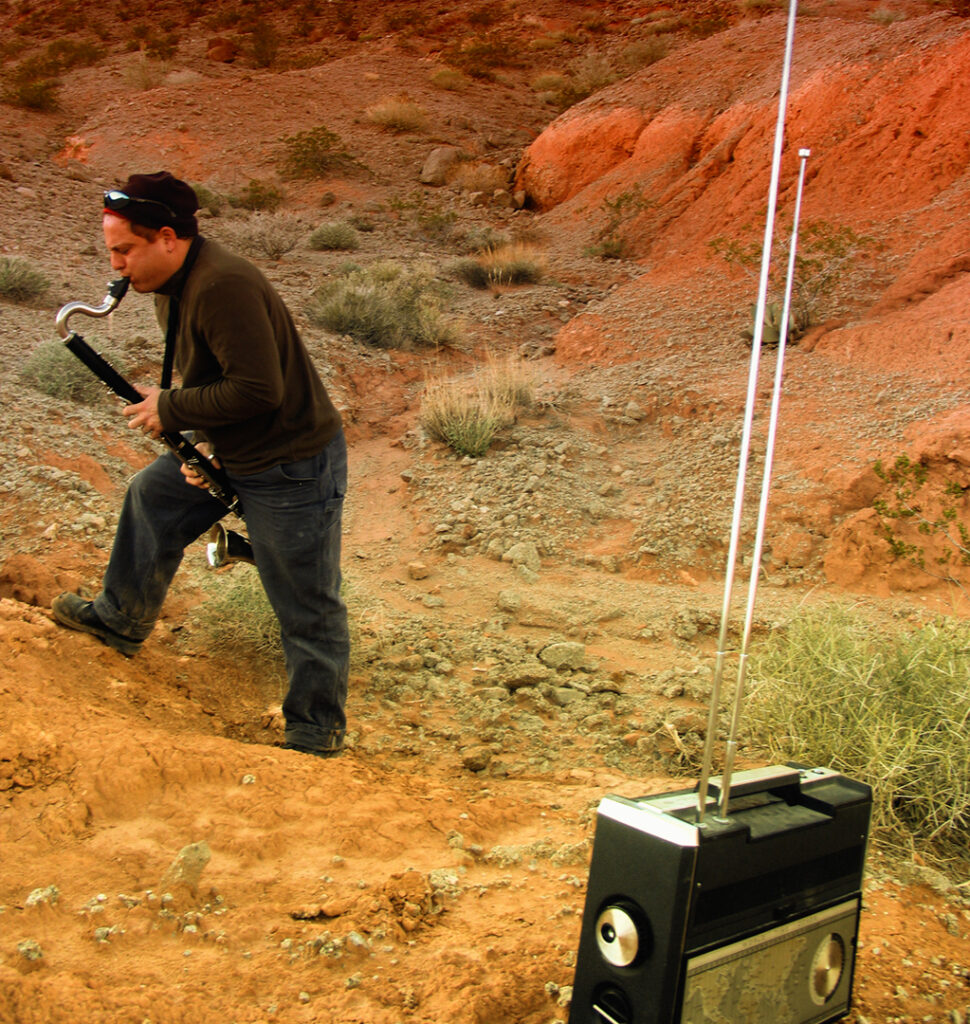
Performances and Interventions
The land in the eastern region of Las Vegas causes one to be keenly aware of geography, geological process, and human intervention. Although the desert looks constant and rigid, one quickly finds out when looking carefully that the desert is time based on an epic scale, every geological processes and millions of years of land formation detailed in every rock protrusion and hill, the decay of human fragments caused by the meteorological conditions is an accidental time-based work, stretching and collapsing depending on material science, chemistry and physics. It is a post-nature archeological site. Collaborative projects have been made her with other artists. Some sound and video interventions were recorded.
Exhibits
While most of the projects happen and stay at Sunrise Mountain, a set of works derived from the experiences were put together as an exhibition at the Clark County Government Center Rotunda in Las Vegas. Each work represented an example of a project that might be completed at Sunrise Mountain.
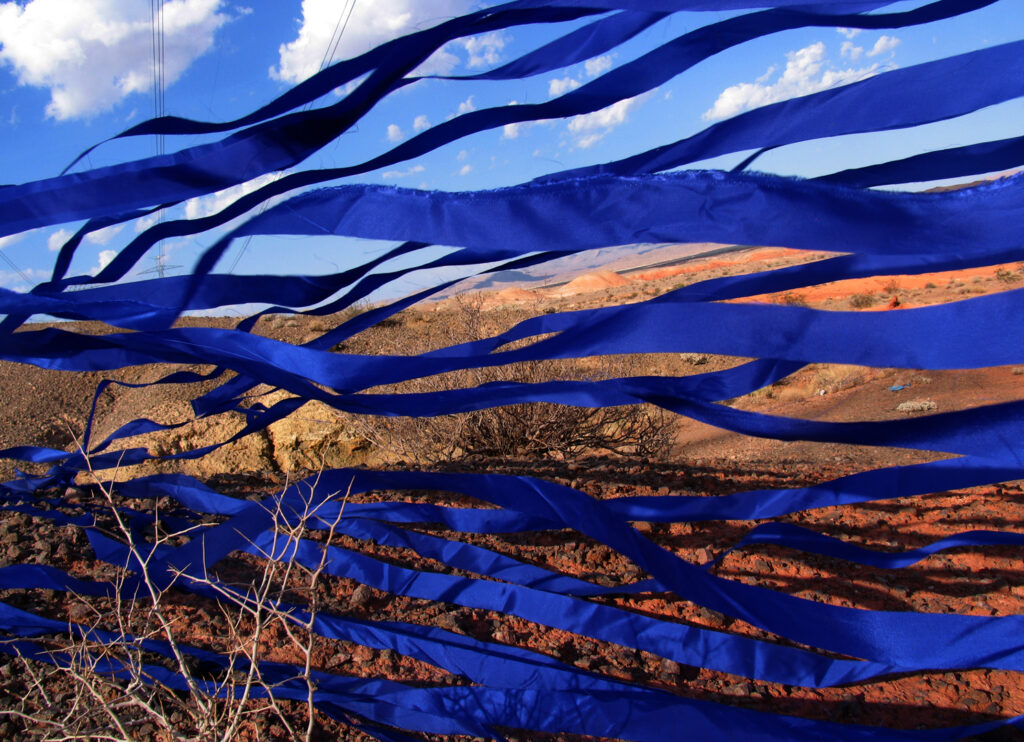
e. Desert Automation
Desert automations are a combination of interactive, kinetic, transformative and generative sculptural works that exist in pre-determined geolocations scattered on the interstitial boundaries of wild and urban ecologies. Sites are visited by chance encounter or through GPS coordinates. Each site is an incursion on the landscape and a modification of the intended terms of abandonment. The duration, condition, and activity of the the sculptures vary and transform according to predetermined processes. The project is a study of urban and social impacts on ecologies and invites thoughts about human interruption in the landscape.
Intent
While working on several different projects in the desert southwest near the vicinity of area 51 and the Nuclear Test Sites, I habitually came across domestic appliances left abandoned in the scrub and creosote. Refuse and garbage in the desert is not unusual, it is analogous to the abandoned satellite and spaceships parts moving uncontrollably about our near space. They are also like asteroids in the Kuiper belt beyond Neptune, elements cast out and discarded by organized systems. Human refuse in the desert is characterized by its rapid decomposition and interjects itself within prehistoric and ancient ecologies that persist despite the damaging effects such human-made intrusions create. Humans tend to remove inoperable, damaged, or obsolete objects from their residences and place them in natural landscapes, out of view of local authorities or a transiting public. While this may be an effective way to hide things in a thickly forested area, the desert has little capacity to make these objects “disappear”. The documentation of abandonment and subsequent decay of objects left in the wild is an alluring social and environmental subject I undertook with Beyond Sunrise Mountain. I wanted to start a new project that could shift the pretext, impact, articulation and deterioration of objects left behind. The intent of abandonment can be changed to a purposeful realization of alternate systems of human interventions on landscape.
A set of criteria of design criteria was created to guide the production of these new intrusions on the landscape.
Transformation: Must transform over time using controlled methods: This can be accomplished through wind power, solar power, gravitational pull, material decomposition and corrosion.
Autonomy: The work must actively change and do so independently and without service or repair.
Interruption: The work should serve as an intentional temporary interruption of the landscape while respecting the natural biology and landscape.
Contemplation: The work should activate a contemplative and reflective moment for the viewer upon an encounter.
Geolocation: The work location is made available for view via GPS coordinates, or accidental encounter.
Desert Automation Sites: Project documentation of desert automation has been made available through images and testing carried out over the course of several years.
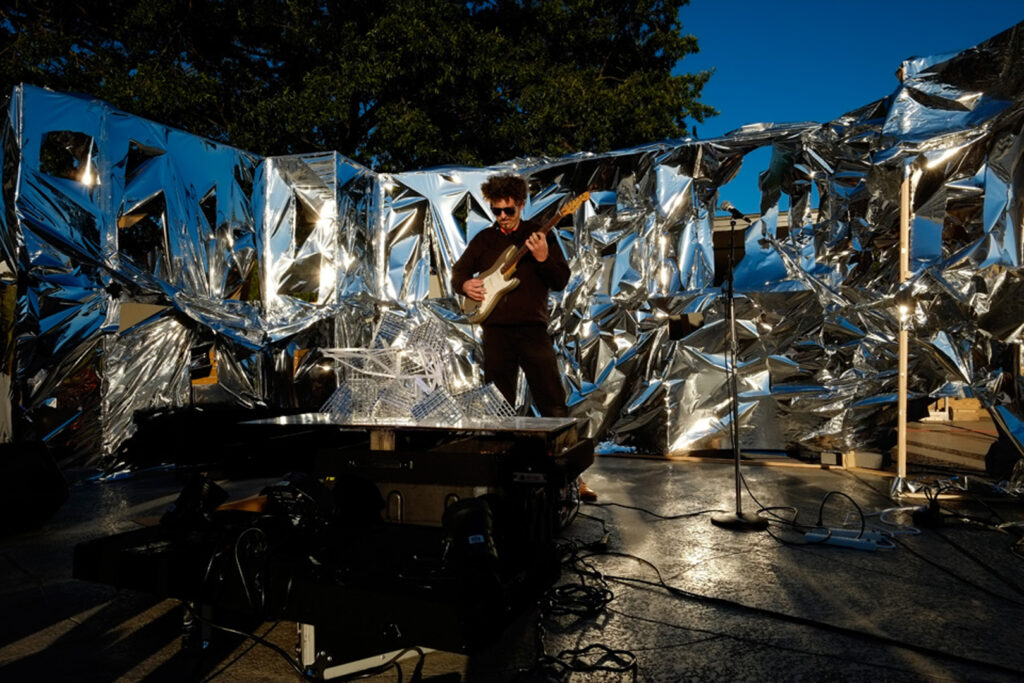
f. metasonic
.. Make something which experiences, reacts to its environment, changes, is nonstable….
.. Make something indeterminate, which always looks different, the shape of which cannot be predicted precisely….
.. Make something, which cannot “perform” without the assistance of its environment…..
.. Make something which reacts to light and temperature changes, is subject to air currents and depends in it’s functioning, on the forces of gravity….
.. Make something which the “spectator” handles, with which he plays and thus animates…
.. Make something which lives in time and make the “spectator” experience time…
.. articulate something natural..
Artist Hans Haacke ,1996
The explorations implicit in Hans Haacke statement inspired a closer understanding of complex evolution of change over time. The constant alteration of our environment provides us with a historical reference and measurement of our creations and that which is natural. Metasonic is a conceptual projection displaying the complexities of our behavior and our environment. In Metasonic, I explore the use sound as a physical force represented through abstract methodologies the chronology of changing landscapes
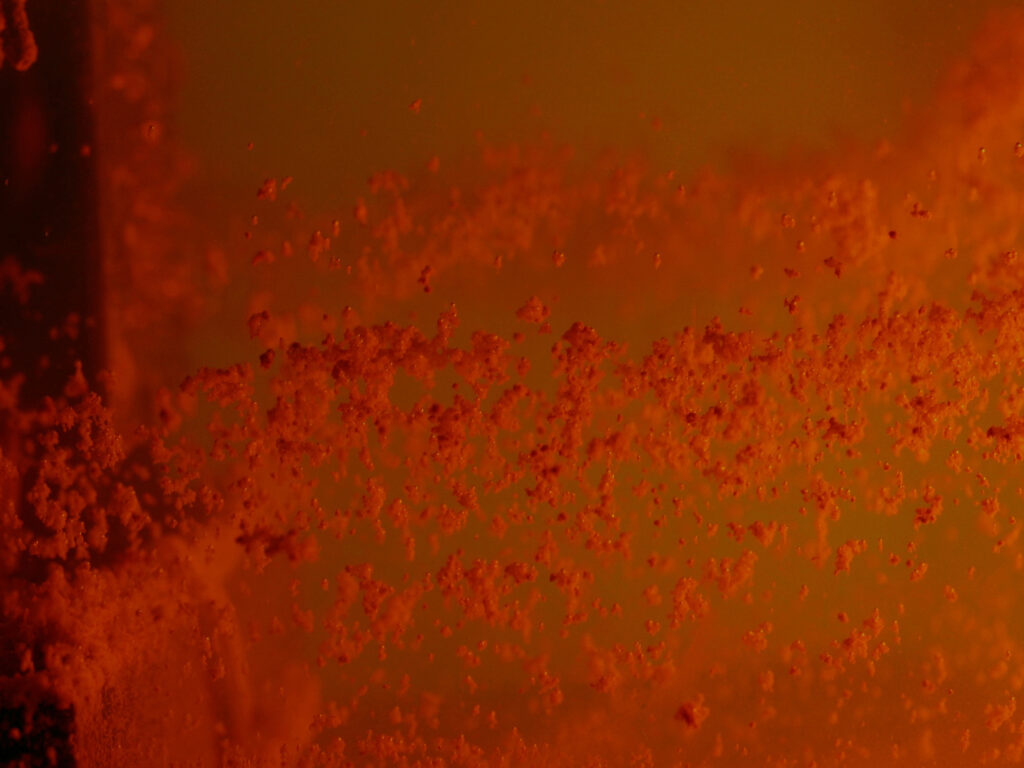
g. Time Remap Sessions
Filmed entirely in the studio in large aquatic tanks, the scenes in the time-remap series were created to evoke thoughts about atmospheric change due to global warming. Each segment of time-remap is an impression of post-industrialism and manufactured ecology. The objects filmed in the tanks were all found, discarded and obsolete electronics. Excerpts of the video and sound installation Time Remap have been shown Nationally. An exhibition at The Brett Wesley Gallery was the first to show the work as the artists had originally conceived; in its full format and as a multi-channel video projection and audio installation.
The 11 segments of time-remap evoke the impression of post-industrialism and manufactured ecology. The video and sound correspond to a visceral response to transitions in time; sometimes viewed as monumental and sometimes microbial the effect rendered is that of a an exotic or alien environment that is in constant change.
The works were produced in collaboration with Craig Colorusso. Craig Colorusso and David Sanchez Burr have been collaborating on various projects since 1996. They met at the Citizen Gallery, a community art space started by Sanchez-Burr in 1994.
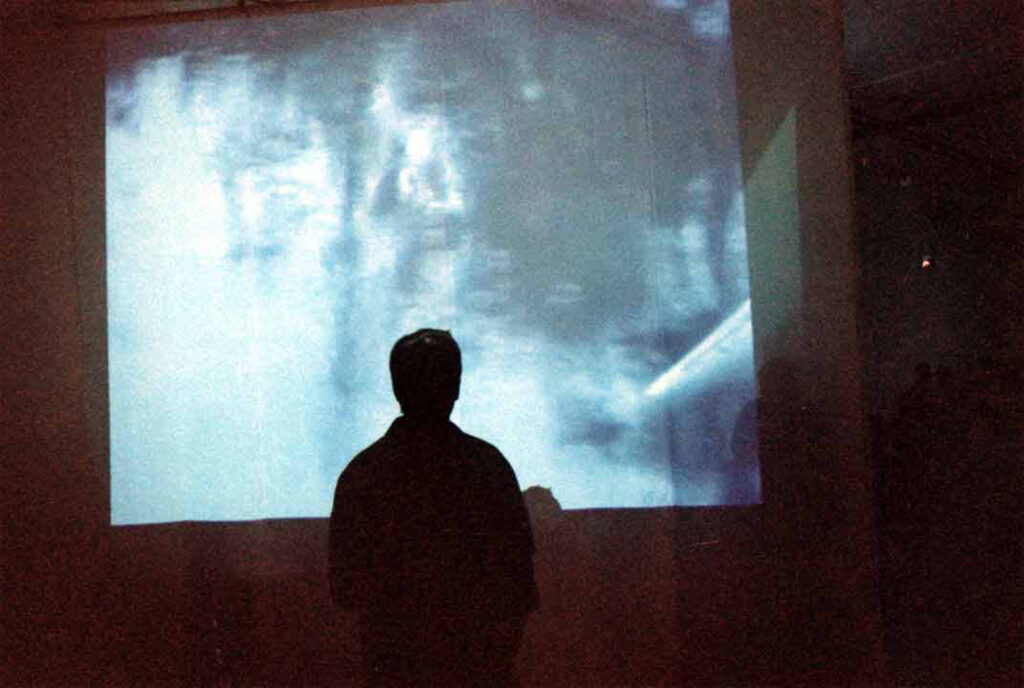
h. ansurbana
Ansurbana’s encouraged collaborations with artists from different genres to create new methods of composing, and presenting time-based work in visual and performance arts. The project required coordination and direction to orchestrate performances in cities across the United States. I prepared proposals, publicity, web development, travel arrangements to enable large-scale multimedia performance exhibits. Founded in 1992 in order to tie together my deep interests in the visual and performance arts, ansurbana performances were created in San Francisco CA, New York, NY, Richmond VA, and Atlanta GA.
I. Additional Exhibits and Works
Oscillations- 36 37 02 N 114 20 41 W at Double Negative
I was invited to be a part of a curated group exhibit that explored artistic intervention in the Great Basin Region of the Southwestern United States. The audio performance took place at the site of renown artist Michael Heizer’s seminal work Double Negative. The performance included two weather balloons that were used as positional instructions for the use of a theremin. The theremin is an instrument that uses the body’s natural electromagnetic field to create and generate tones and frequencies; by using one’s hands the instrument can be played. In this performance the hands were guided by atmospheric movements of the balloons in the sky, along with an analog synthesizer an improvised score was developed by the changing wind and atmospheric conditions.
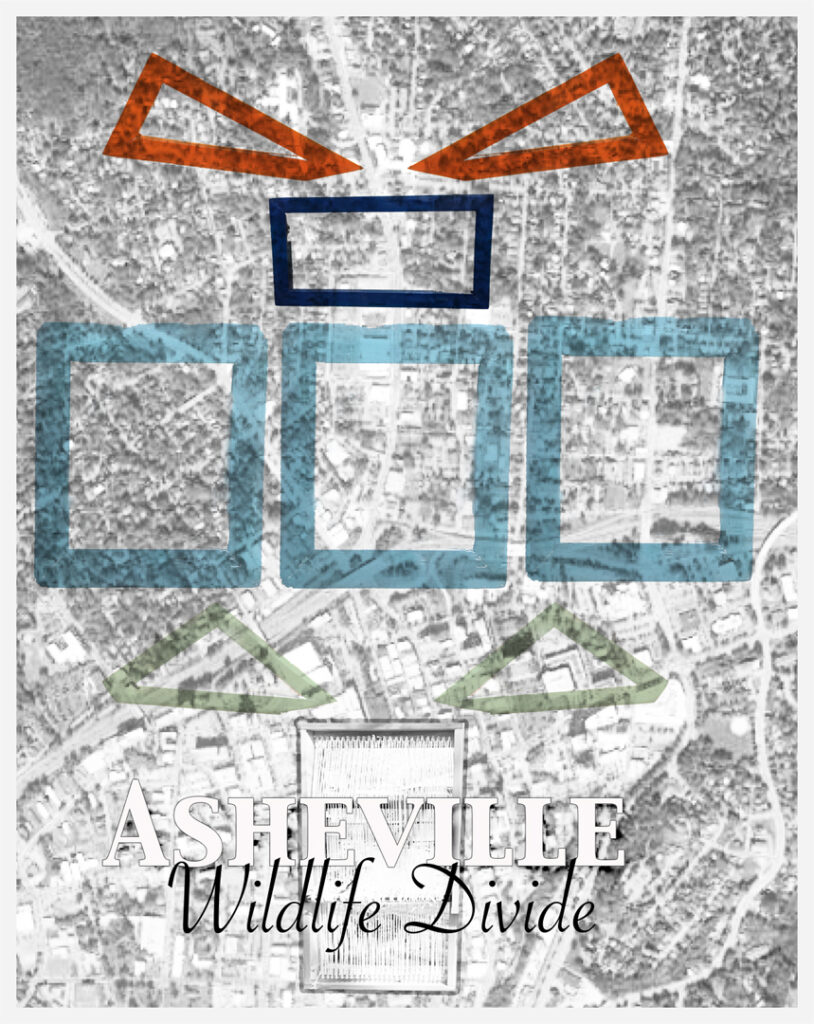
Wildlife Divide in Asheville, NC
The Wildlife Divide Asheville is an extension of a project that started in Las Vegas, Nevada. The project highlights the resounding differences and high contrast between natural and urban habitats and explores where the two intersect.
Asheville is one of the most beautiful cities I have ever visited. With its setting in the Appalachian Mountain Range and its long history of artistic creativity, Ashville inspired me to invite two locals in the community to explore the area around the Black Mountain College Museum and Art Center. Our task was to find places where wildlife thresholds could exist, places where remnants of what once was or could be for our ecological and urban futures could be seen. Two locals Anna Toth and Asia Suler agreed to work on this project.
The Wildlife Divide is a walk through 4 locations in Asheville, while discussing documentation of time, the ecology and natural dye fabrics and fibers that can be sourced from plants in the landscape.
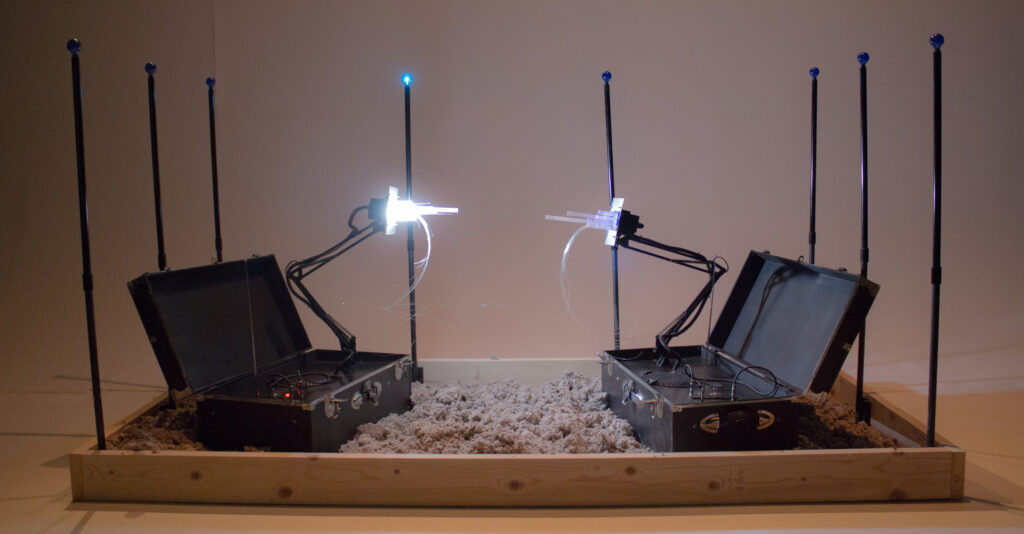
The Isossymmetry, I Miss You
An invitation to exhibit my work at a light based artwork festival in Chapel Hill, North Carolina became a prompt to create a new electronic work that used the theremin for interaction. The distance between my residence in New Mexico and North Carolina necessitated that the work be portable, the distance also caused reflection of my own experiences of missing someone. Frustrated by the lack of warmth of digital communication I made two robotic armatures that would say “I miss you” to each other in code. The two armatures were programmed to create light pulses translatable to the words “I Miss You” in morse code. The two armatures were designed to fit in two rugged suitcases, theremins were added to the design in hope that audience interaction would add human warmth to the work. The suitcases were exhibited open and facing each other, repeating a looped code of “I Miss You” to each other.
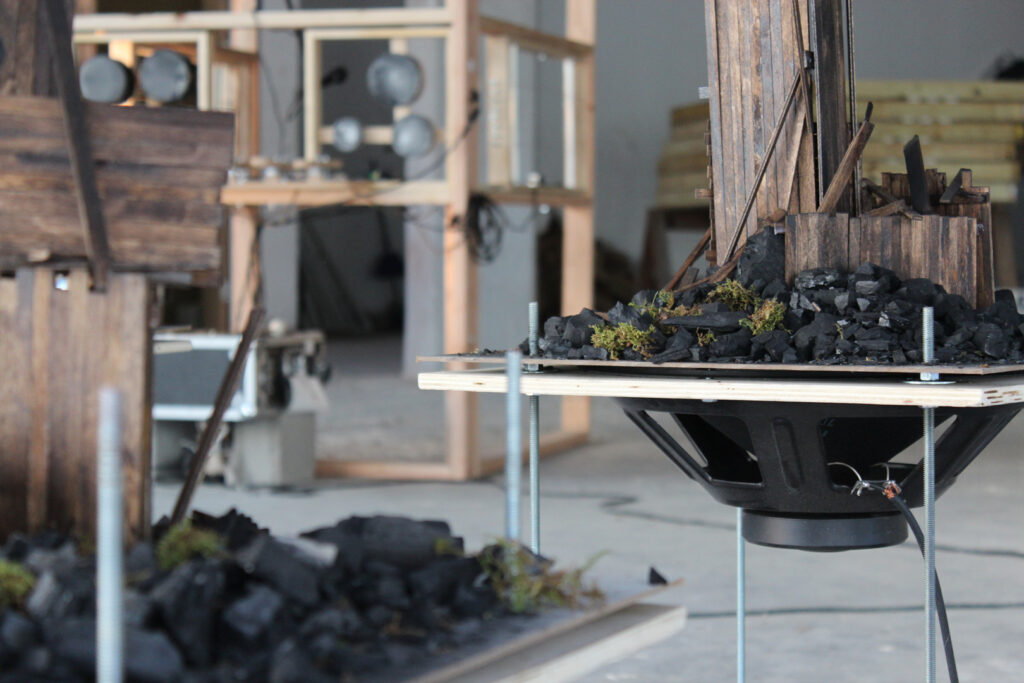
These Fractures go Largely Unnoticed
This artwork was made in response to an invitation to exhibit my work in Memphis, Tennessee as part of an Apex Art funded exhibit called Memphis Social. Inspired by many cross country travels and viewing the landscape and changing environments across the country, I became interested in the evolution of agriculture in the United States. As one travels on the interstate system a common site are abandoned farm structures. The phenomena is caused by the replacement of the family farming system to larger industrial scale farms that are more profitable and hold many competitive advantages. The result is the slow and persistent decay of abandoned small farm operations all over the south and midwest of the country. Flat, arable land was the easiest to commercialize at large industrial scales. The elimination of natural ecosystems and the further flattening of the land caused these structures to rise in prominence along the highways. The work also references Memphis and its history in radio broadcasting. To the west of Memphis begins the long reaches and expanses of flattened agricultural land. Local radio stations were able to reach people, and many small towns had one. The communications industry mimicking the commercialized process of agriculture, began to build large scale broadcasting syndicates, resulting in the closing of smaller local stations. Like the small farming system the local broadcasting systems became symbols of obsolescence.
I created a temporary radio station in downtown Memphis and used techniques learned from works in the Metasonic Project to create a work that would decay over time using the sounds of the radio station. Four platforms were used to stage farm-like structures, vegetation and earth materials. As audiences interaction with the radio station increased, so did the flattening and decay of the sculptural work.
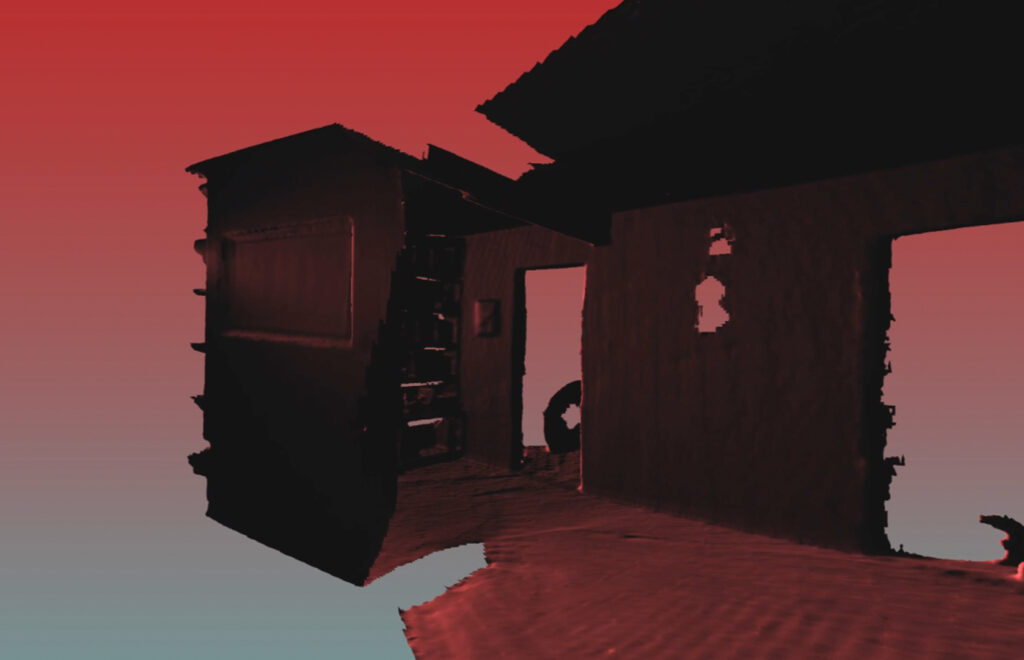
The Room
Part of the Hellen Keller Project exhibition that I was invited to at Alfred University in New York. The Room is a three-dimensional soundscape of my living room. The possibilities of spacial reconnaissance while recording sound is often overlooked, the sound recording and the video accompanying it are recordings in sound of my pacing every square foot of the living room, each step has a unique effect on the creaking wood, creating spatial coordinates. The bending and the warping of the wood floor cause a guitar cantilevered over a table to create the guitar sound. The video is a three dimensional scan of the room as it floats in space. The incomplete scan is analogous to the incomplete understanding we often have of space and time.
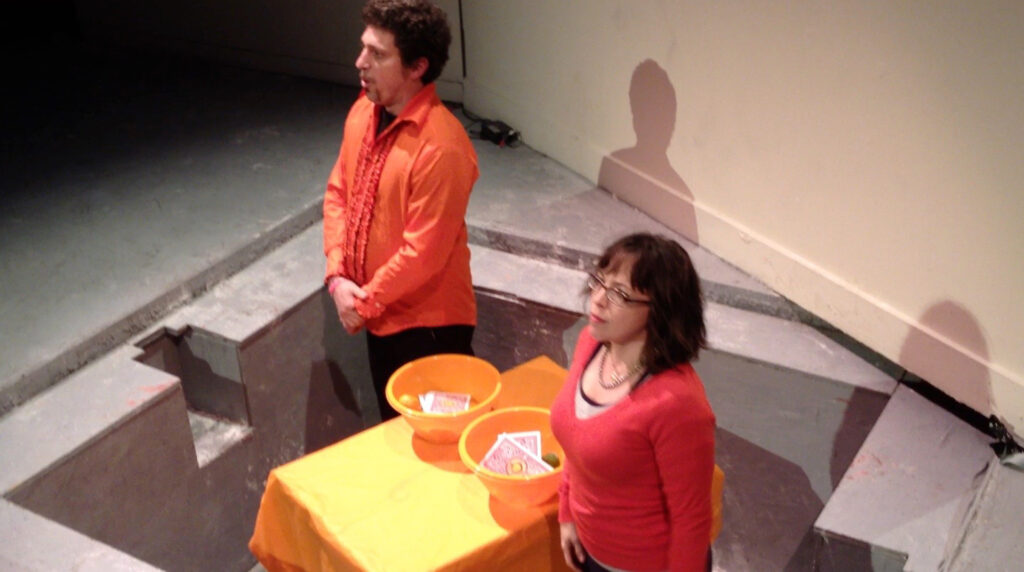
Tangerinomics
Tangerinomics was a performance collaboration with artist and writer Danielle Kelly. The performance highlighted references to the California citrus industry, profiteering and late capitalism. The performance was created for 100 Performances in the Pit at SOMARTS, in San Francisco curated by Justin Hoover.
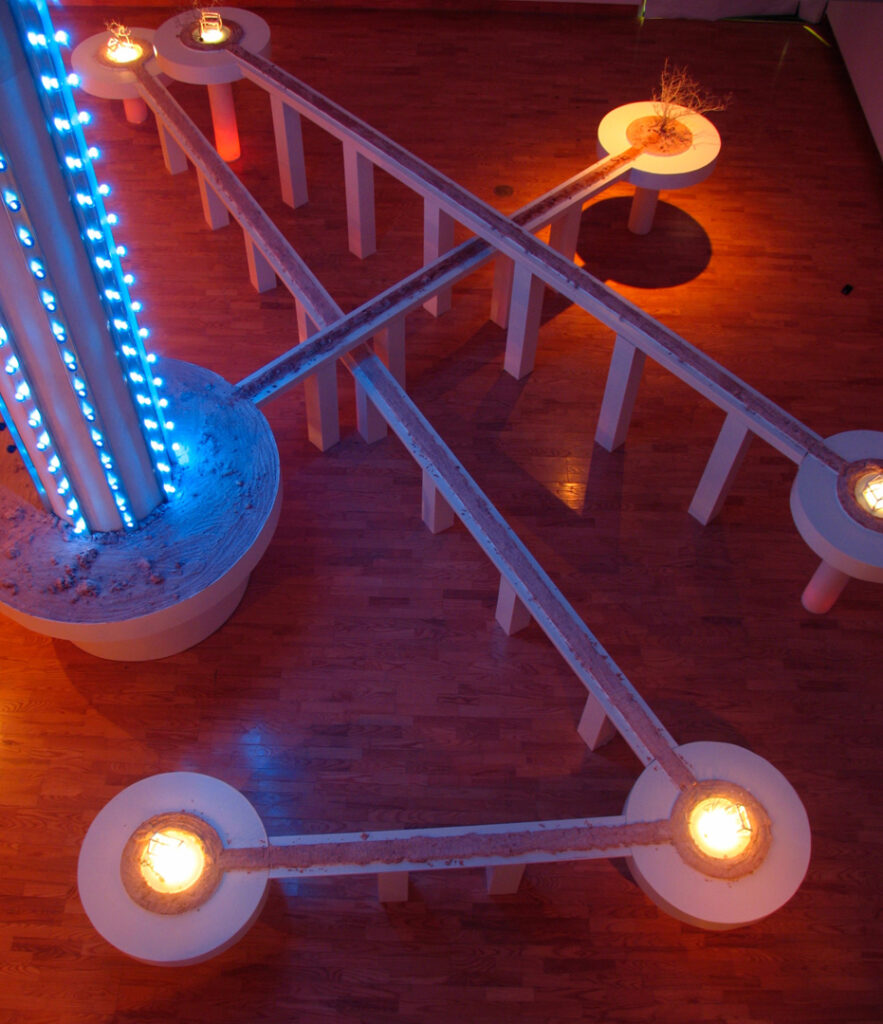
Emergency
Emergency was my thesis exhibit at the Donna Beam Arts Gallery at the University of Las Vegas, Nevada. In 2008 Las Vegas saw the precipitous decline of home values, rising mortgage interest levels, massive job losses and drastic government budget cuts. The bleak outlook of this rising western metropolis was a reminder of the fragility of economic systems. The desert is not a forgiving place for those in despair. Highlighting these conditions in contrast with the vast sprawl, luxuriousness of new resorts and spectacle of the Las Vegas Strip, Emergency was a reaction to the collapse of the great recession. Unobstructed mass development and clearing of the landscape to accommodate neighborhoods that spontaneously became empty and void of residents was a story that was carried nationwide for many months on major news media. The exhibition was a large sculptural work composed of connected cul-de-sacs, a commonly used terminus in large residential developments. At the center of the installation was a twenty four foot tall light sculpture analogous to the nightly spectacle of the Las Vegas Strip. The light installation had flashing light combinations responding to sounds made by visitors of the exhibition.
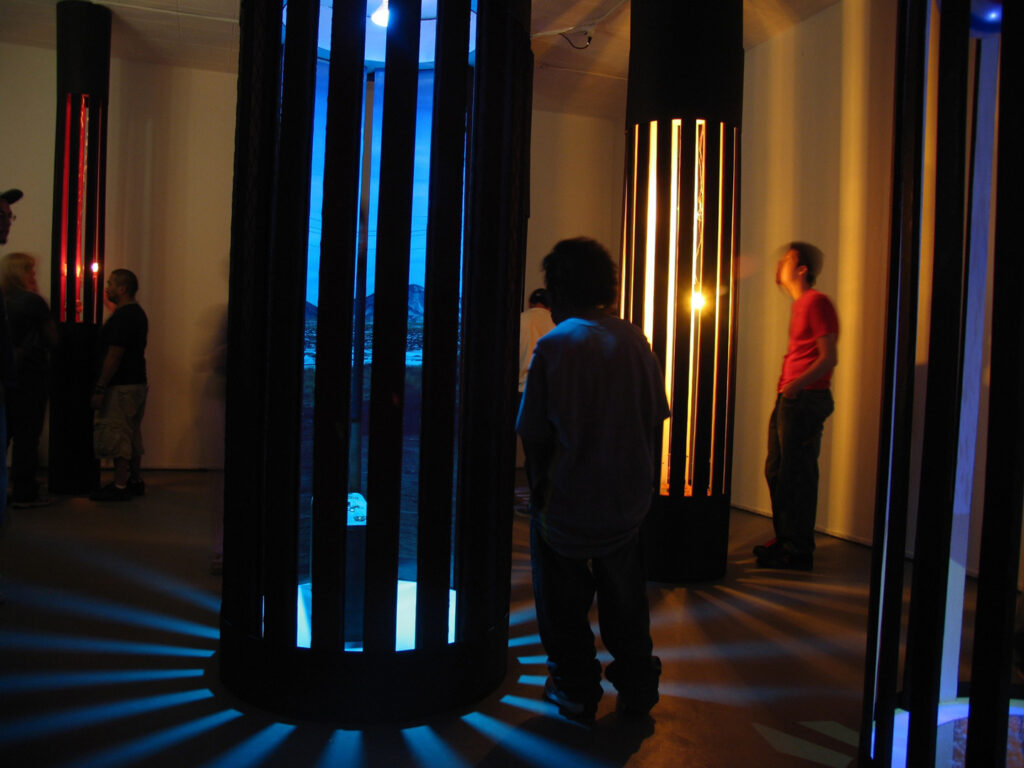
Beauty is On The Inside, Too
Beauty is on The Inside Too Installation November 2007 David Sanchez Burr
There are two main concepts that this installation was designed and conceived to address. One is to emphasize the psychological structure-building behind the creation of a “persona ” while living in a society with others, this structure I call the edifice. The second main concept of the installation is to engage the practice of removing the relevance of the room as a space to exhibit work that in fact carries within all it needs to be exhibited anywhere. The pieces in this installation were constructed to simultaneously conceal and reveal the importance of what lies within and not the exterior surface. Common experiences such as work/labor, solitude, travel, geography, introspect, and hope were represented as such in each piece.
Two different versions of this work were created one for an Exhibition at the University of Nevada, Las Vegas and the second for InLight Richmond in conjunction with the 1708 Gallery in Richmond, Virginia.

Four Easy Pieces
This exhibit was a collaboration with Berlin based artist Jens Luestraeten. The exhibition focus was to approach different aspects of urban phenomena on levels of personal reflection and socio-political consequence. Four single channel video works were made as gestures towards our over spun real-time social spectacle in Las Vegas and its challenges with short attention span, over stimulation and propensity towards instant gratification. Las Vegas, America’s fastest growing city, is also an urban area loaded with contradiction. Theoretical interpretations of what Las Vegas is and what it will become included ideas about basic needs such as water, shelter, and climate control. The city’s asphalt and concrete now cover what was once a desert. The exhibition highlighted the benefit of patience to view changes over time.
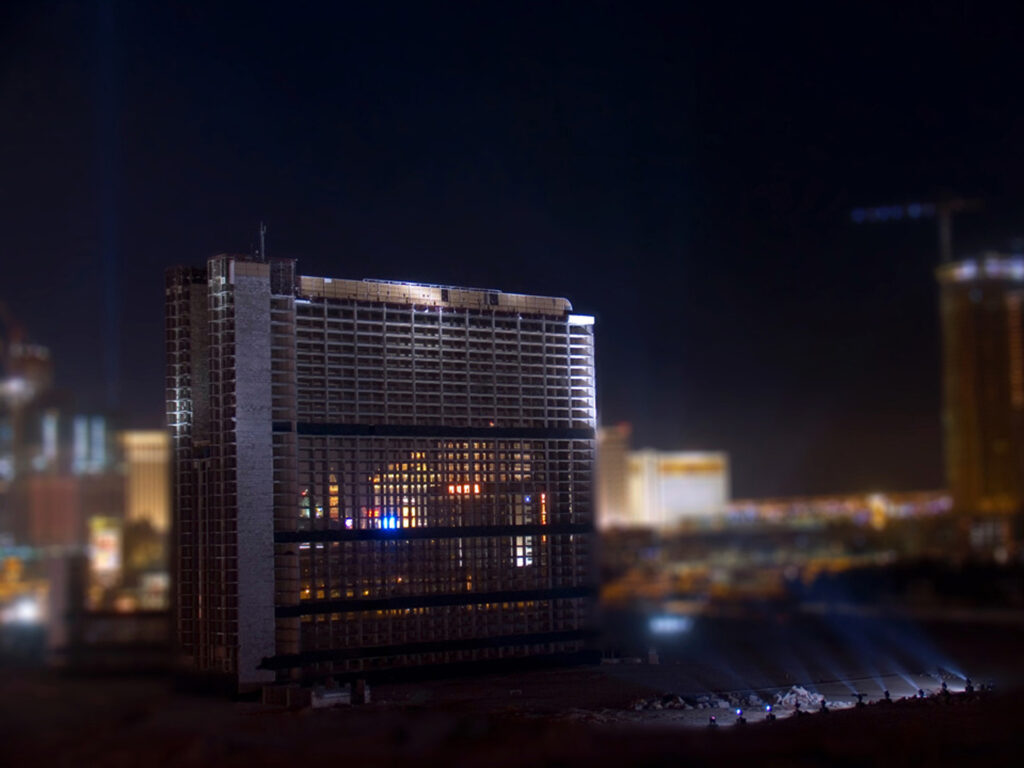
Stardusted
Stardusted is a video that features a performance at the Stardust Casino on October 31, the day before its closure in 2006 and a video of the Casino’s implosion on March 13, 2007. The implosion of a casino may not seem that big of a deal in a town where reinvention is not only a mantra but a self preservation skill. The effect of implosions is also a warping of memory, a catastrophe wrapped in a spectacle. In a region where non-native history is a relative blink of an eye it is rare that nostalgia, sincere and heartfelt, gushes out like an artesian well. This is precisely what happened with the closing of the Stardust. The implosion was intended to make space for a new and more modern resort property. The Stardust was a placeholder of memories of a more “classic” era, an era packed with human stories, a concentration of nostalgia. Like many structures in history while we preserve the symbolic, sometimes we are only left with the memory. The implosion was staged as an elaborate and unsolicited lesson in modern global economic decision making, a show of force, and a spectacle. The work was screened widely and was included in an exhibit at the Cantocore Gallery in Guanzhou, China.
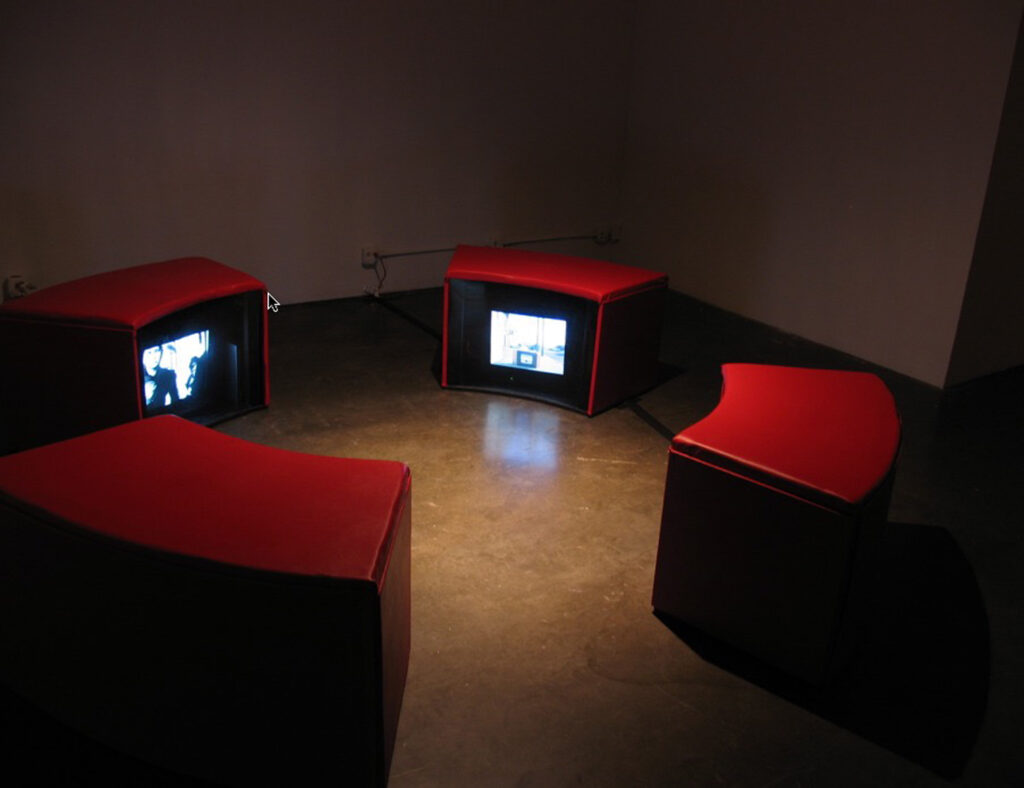
Videoplace
In videoplace, I used a synchronized four channel video and sound installation that the audience can manipulate through interaction, the video work highlights the effect of human interaction on both in urban and rural settings. The audio work was completed in collaboration with Craig Colorusso, an artist and frequent collaborator.
